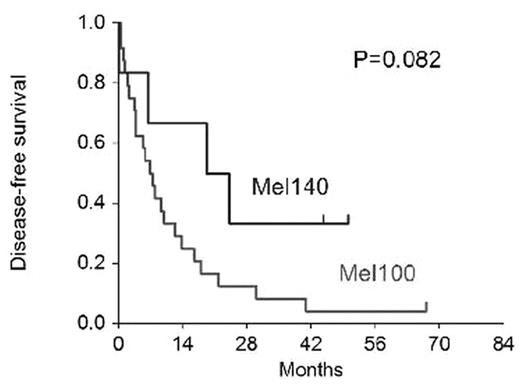Abstract
The dose of melphalan affects the outcome of autotransplantation in myeloma significantly. Regimens not containing melphalan or doses of melphalan lower than 200 mg/m2 have been shown to result in inferior disease-free (DFS) and overall (OS) survival (Mehta J, Singhal S. High-dose chemotherapy and autologous hematopoietic stem cell transplantation in myeloma patients under the age of 65 years. Bone Marrow Transplantation advance online publication, 6 August 2007; doi:10.1038/sj.bmt.1705799). However, whether the melphalan dose affects the outcome of allogeneic HSCT is unknown. The outcome of 30 patients undergoing submyeloablative allogeneic HSCT after 100 mg/m2 (n=24) or 140 mg/m2 (n=6) melphalan was studied to determine the effect of melphalan dose-intensity. The higher melphalan dose was combined with 150 mg/m2 fludarabine. As the figures below show, DFS and OS appeared to be better after the higher dose of melphalan on unadjusted analysis.
The following variables were studied for their effect on OS: patient age, donor age, chemorefractoriness, HLA mismatch, melphalan dose, performance status, and LDH level. The factors found to be significant in univariate analysis - donor age, performance status, LDH, and chemorefractoriness - were entered into a Cox model. The dose of melphalan was forced into the final model. The table below shows the factors found to significantly affect relapse, DFS and OS in multivariate analysis. No factor was found to affect transplant-related mortality significantly.
| Adverse variable . | RR . | P . |
|---|---|---|
| Relapse | ||
| Refractory disease | 5.5 | 0.02 |
| DFS | ||
| Elevated LDH | 3.5 | 0.017 |
| Donor age >45 | 3.4 | 0.024 |
| Refractory disease | 3.5 | 0.044 |
| OS | ||
| Elevated LDH | 8.0 | 0.002 |
| Performance status 2/3 | 5.8 | 0.003 |
| Donor age >45 | 4.1 | 0.031 |
| Adverse variable . | RR . | P . |
|---|---|---|
| Relapse | ||
| Refractory disease | 5.5 | 0.02 |
| DFS | ||
| Elevated LDH | 3.5 | 0.017 |
| Donor age >45 | 3.4 | 0.024 |
| Refractory disease | 3.5 | 0.044 |
| OS | ||
| Elevated LDH | 8.0 | 0.002 |
| Performance status 2/3 | 5.8 | 0.003 |
| Donor age >45 | 4.1 | 0.031 |
The melphalan dose did not affect relapse (P=0.37), DFS (P=0.16) or OS (P=0.12) significantly. These data suggest that 100 mg/m2 and 140 mg/m2 melphalan doses appear to result in comparable outcomes after allogeneic HSCT in myeloma. This is probably because the immunologic graft-versus-myeloma effect compensates for the reduced anti-myeloma efficacy of the lower melphalan dose. Whether higher melphalan doses, used successfully as pre-allograft conditioning for hematologic malignancies (Singhal S, Powles R, Treleaven J, Horton C, Mehta J. Melphalan alone prior to allogeneic bone marrow transplantation from HLA-identical sibling donors for hematologic malignancies: alloengraftment with potential preservation of fertility.
Author notes
Disclosure: No relevant conflicts of interest to declare.



This feature is available to Subscribers Only
Sign In or Create an Account Close Modal